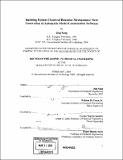Building robust chemical reaction mechanisms : next generation of automatic model construction software
Author(s)
Song, Jing, 1972-
DownloadFull printable version (21.53Mb)
Other Contributors
Massachusetts Institute of Technology. Dept. of Chemical Engineering.
Advisor
William H. Green, Jr. and George Stephanopoulos.
Terms of use
Metadata
Show full item recordAbstract
Building proper reaction mechanisms is crucial to model the system dynamic properties for many industrial processes with complex chemical reaction phenomena. Because of the complexity of a reaction mechanism, computer-aided reaction mechanism generation software appeared in recent years to help people efficiently build large reaction mechanisms. However, the limitations of those programs, such as not being able to model different types of reaction systems and to provide sufficiently precise thermodynamic and kinetic parameters impede their broad usage in real reaction system modeling. Targeting the drawbacks in current first-generation reaction modeling software, this thesis presents the second-generation of reaction mechanism construction software, Reaction Mechanism Generator, (RMG). In RMG, a new reaction template method is proposed to help quickly and flexibly define different types of reaction families, so that users can easily characterize any reaction system of interest without modifying the software. Furthermore, this work also presents new functional group tree approaches to construct hierarchical structured thermodynamics and kinetics databases for managing a large number of parameters, so that people are able to quickly and precisely identify better kinetics for different reactions in the same reaction family and to easily extend and update the databases with the latest research results. This new data-model dramatically improves the interface between the chemistry and computer science, removing many of the ambiguities that have plagued the field of chemical kinetics for many years, and greatly facilitating the maintenance and documentation of both the software and the databases that provide the key inputs to any chemical kinetic model. (cont.) The author applied object-oriented technology and unified modeling language in system analysis, architecture design, and implementation of RMG. Therefore it is designed and developed into a robust software with good architecture and detailed documentation, so that this software can be easily maintained, reused, and extended. RMG is successfully applied to generate a reaction mechanism for n-butane low temperature oxidation, which includes a complex autoignition process. The model generated by RMG caught the fundamental phenomena of autoignition, and the predicted ignition delay time and many major products' yields are in very good agreement with experimental data. This is the first time that model generation software automatically generated such a complicated reaction mechanism without human interference, and provided precise predictions on ignition delay and major products yields consistent with experimental data.
Description
Thesis (Ph. D.)--Massachusetts Institute of Technology, Dept. of Chemical Engineering, 2004. Includes bibliographical references (p. 308-319).
Date issued
2004Department
Massachusetts Institute of Technology. Department of Chemical EngineeringPublisher
Massachusetts Institute of Technology
Keywords
Chemical Engineering.